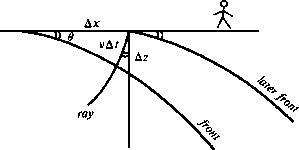 |
Figure 1 Wavefront arrival at earth's surface, showing that observation of dt/dx gives the ratio
Earlier a Snell wave was defined as a plane wave that has become nonplanar by moving into a velocity-stratified medium v=v(z). A plane wave keeps its angle of propagation constant, while a Snell wave keeps its stepout dt/dx a constant function of z. Figure 1 shows a Snell wave incident on the earth's surface.
 |
The wavefronts at successive times are not parallel to each other; they are horizontal translations of one another. The slowness of horizontal motion is called the stepout. It is measured in units of inverse velocity and is given as milliseconds per meter or as seconds per kilometer. The slowness, denoted as p, is also called the ray parameter or the Snell parameter:
| |
(1) |